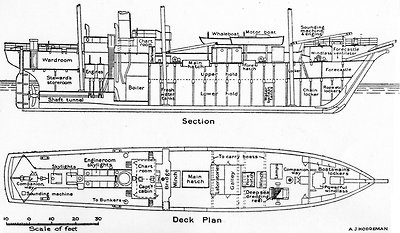Whaler turned explorer
In their own words
The primary consideration in the design of a vessel built to navigate amid the ice is that the hull be very staunch, capable of driving into the pack and of resisting lateral pressure, if the ice should close in around it. The Aurora … was built in Dundee, and though by no means young was still in good condition and capable of buffeting with the pack for many a year. — Douglas Mawson, The Home of the Blizzard
… the stout Dundee vessels used in the whaling and sealing industry in the Arctic, … were employed by all the early Antarctic expeditions, and their heavily built wooden hulls no doubt saved these navigators from disaster in the moving pack-ice time and time again.
— JK Davis, High Latitude
As, repeatedly, I asked of the old Aurora more, perhaps, than I had the right to ask, and as without fail she performed what was asked of her, I began to rely on her in much the same instinctive way and to much the same degree that an athlete or a mountaineer relies on his arm or his leg. She was a magnificent ship.
— JK Davis, High Latitude
Aurora began its life in 1876 as a whaler-sealer in a fleet operating out of Dundee, Scotland. Each year the Dundee fleet crossed the Atlantic to Newfoundland where its crews hunted seals among the ice floes before heading north to hunt for whales around Greenland.
In 1884 Aurora was involved in the search for members of a United States Arctic expedition stranded on Ellesmere Island since mid-1883. In response to a $25,000 reward offer, Aurora and two other Dundee whalers headed into the Arctic ice. The survivors were found by another vessel, but not before the men of Aurora spent some anxious hours in the grip of moving sea ice.

